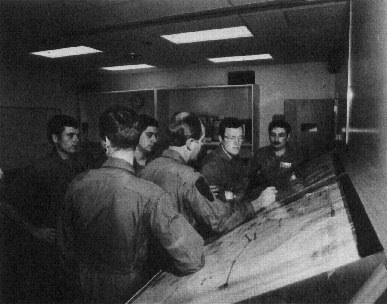Gunship Academy
by Richard Sheffield
So You Want to Fly the Apache
Becoming a part of Army aviation today is very hard, but not impossible. The Army is always looking for good pilots, so in order to attract as many candidates as possible, they created the Aviation Warrant Officer program.

What exactly is a Warrant Officer? A Warrant Officer is kind of a cross between a commissioned officer and an enlisted person. He or she is an appointed officer needed for a particular skill. The Army defines a Warrant Officer as follows: "Any officer appointed by warrant by the Secretary of the Army, based on a sound level of technical and tactical competence. The Warrant Officer is the highly specialized expert and trainer who, by gaining progressive levels of expertise and leadership, operates, maintains, administers, and manages the Army's equipment, support activities or technical systems for an entire career." The Warrant Officer program is the quickest way for someone just out of high school to get into military aviation (since a college degree is not required as is the case with pilot candidates in the other services).
So the first thing you have to do in order to fly the Apache is get into the Warrant Officer program. The program has the following requirements for application:
You must be a high school graduate. A GED will not do unless you have two years of college.
You must be at least 19 years old and not older than 30.
You must have perfect 20/20 vision.
You must be a U.S. citizen.
You must pass a very thorough flight physical.
You must pass a series of mental examinations.
If you can meet those requirements, then you get to apply for one of the slots to come open in the future. To apply, all of your personal information, a stack of references, and a handwritten letter (spelling and punctuation count) stating why you want to be an aviation Warrant Officer candidate are forwarded to the national selection board, who will vote on you. If you are not selected, you will never know why since no explanation is required. Once you pass this hurdle, you'll have to wait for a slot to come open. This sometimes takes up to ten months.
Having gone through that exhaustive process to get in, once there, you get to fly, right? Wrong. The first thing the Army will do is ship you off to Fort Jackson, South Carolina, for two months of basic training. You are a soldier first, and then a W/O candidate, so you must be taught to run, shoot, and act like a soldier.
After this grueling two months of basic, now you get to fly, right? Wrong again. Now you get to spend six weeks in the Warrant Officer Candidate Military Development Course. This is a rigorous course that teaches basic military leadership skills and professional development. During this period, the Army finds out just how badly you want to fly helicopters. You are constantly evaluated by your peers and hassled by your superiors. Weak or unmotivated candidates are weeded out before the Army wastes money teaching them to fly.
Now do you get to fly? Yes, now you finally get to fly at the Army Aviation Center in Fort Rucker, Alabama—but the pressure is by no means off. While the basic Rotary Wing Aviation Course is 36 weeks and two days long, if you do not solo in a helicopter by the fourth or fifth week, you are eliminated from flight training.
This course takes the student aviator from basic training in the TH-55 helicopter all the way to combat training, night-vision goggle qualification, and flight qualification in the UH-1H Huey or OH-58 Kiowa. A candidate leaving this school can not only fly but is able to perform the basic tasks of a new assignment.
If you're one of the top performers in flight school, you might get the chance to go on to learn to fly the AH-1 attack helicopter. Upon successful completion of this course, you'll be assigned to an Air Cavalry or Attack Helicopter unit. After spending some time there, you'll be ready to apply to fly the AH-64A Apache. The requirements are the following:
Be currently qualified in rotary-wing aircraft
Be qualified in the AH-1S
Have a minimum of two years as an aviator with at least one tour of duty with an air cavalry or attack helicopter unit
Have orders to a unit with the AH-64A
Have a current rotary-wing instrument rating
Be nap-of-the-earth qualified
Have a secret clearance
If you're accepted to fly the Apache, you'll go back to Fort Rucker for three more months of aircraft, classroom, and simulator training.
Well, that's all there is to it. You didn't think that they would turn just anybody loose with a $15 million piece of equipment, did you?
Table of Contents
Previous Section: The Pilots
Next Section: Weapons Systems—Theirs and Ours
